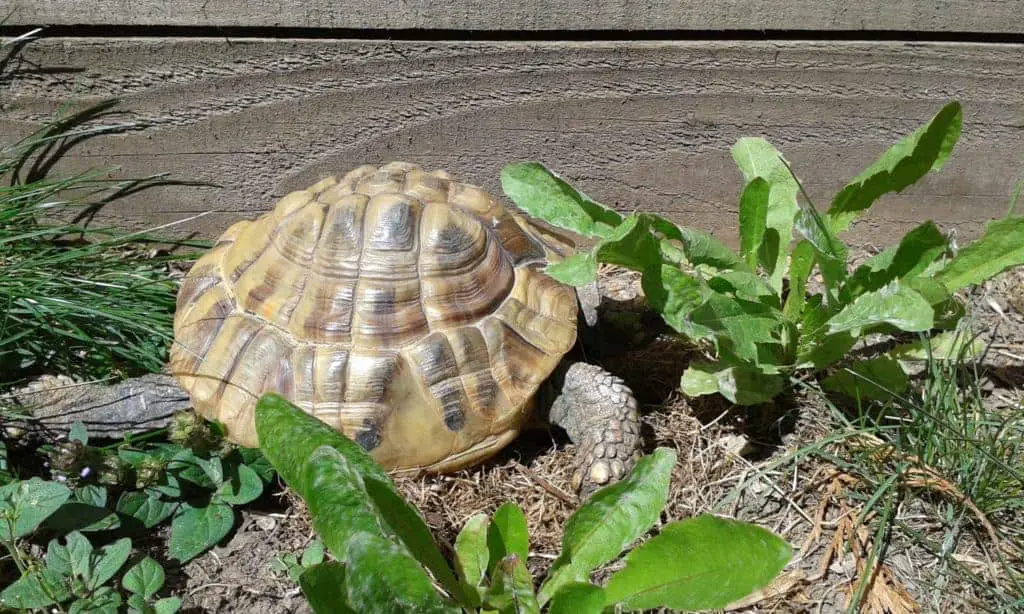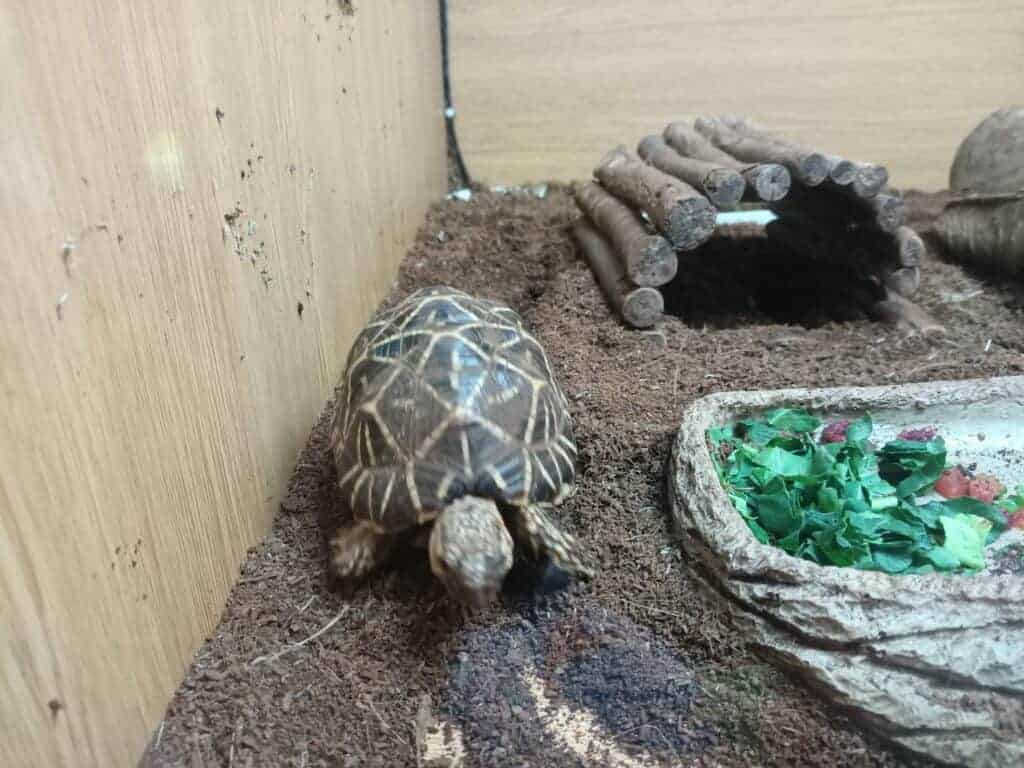The Hermann’s tortoise is the most low maintenance tortoise breed. They are a resilient species, with a varied diet and are able thrive both indoors and outdoors. They usually live for around 50 to 75 years.

Taking care of a tortoise involves certain responsibilities unique to tortoises. It is challenging, and it’s not something to undertake unless you are committed to caring for your pet consistently for many years.
For beginners or people who don’t have the time or space for the most high-maintenance breeds, it makes sense to look into breeds that are are at least slightly easier to take care of (although there is no such thing as a breed that is ‘easy’ to care for). Not only does this help the you owner, but also saves the tortoise from being mistreated unintentionally.
Which Breeds Require the Least Maintenance?
There are several tortoise breeds that don’t need as much maintenance as others. While you still have to take care of them, they are generally accepted as being more resilient than other species, so they might require slightly fewer responsibilities on your part.
They are great for people who have a busier schedule, as well as those who are just starting out as tortoise owners and don’t want to jump into something that exceeds their knowledge, skill set, or available space they can allocate to their tortoise.
As such, if you’re in a similar spot, then here are some breeds that require less maintenance:
- Hermann’s Tortoise
As discussed at the top of the article, of all breeds, the Hermann’s tortoise is the one that needs the least maintenance. The Hermann’s tortoise is a gentle species, and they are known for their affable personalities.
Perhaps it’s telling that the Hermann’s tortoise is one of the most common breeds that people keep as pets, and incidentally they were especially popular in the 70s and 80s (although many were not cared for correctly in those days).
Thankfully these days there is an abundance of literature available on Hermann’s tortoises, which is a great help for the novice owner.
This tortoise is pretty small, usually reaching no more than 11 inches in length and weighing less than 20 lbs. This means their space requirements are slightly lesser than some larger species.
These tortoises are not fit to stay in colder environments. As such, you will need either to create a warm indoor enclosure for them all year round, or during spring and summer, a sun exposed outdoor enclosure.
The ideal temperature for a Hermann’s enclosure is around 70℉-80F (21C-26C). Like all species, they should also have a basking spot and UVB light. Their enclosure will also need high walls, as they can climb and will actively do so given the opportunity.
When they reach three years old, Hermann’s tortoises strongly benefit from hibernation. This will be for a few weeks for the first year or so, up to for 2 or 3 months once they reach adulthood. Once this period is over, you have to bring the enclosure to a warmer area so it can slowly heat up.
Their diet mostly consists of leafy greens, wild flowers and weeds, as well as the occasional bit of fruit as a treat.
- Russian Tortoises
Russian tortoises are also fairly low maintenance, hence they are also commonly found as pets. They can live for over 75 years, so a slightly greater overall time commitment than Hermann’s tortoises, but when it comes to their day to day care regime, things are relatively straightforward.
You can keep these tortoises indoors without issue. They do not necessarily need to hibernate, although they can do if you choose. If you keep them indoors in a warm environment, they will be active all the time. But if you keep them outdoors and temperatures get too low, they will naturally be drawn to hibernate. In order to do so, they’ll need to be able to dig into the ground, so a natural, unpaved yard or garden is essential.
What makes Russians particularly great for beginners is the fact that they can adapt to different temperatures and environments more successfully than other breeds.
Like the Hermanns tortoise, Russians are also pretty small and also have a fun personality, which is what makes people fall in love with them. They need an 8-square feet enclosure, and their space should have a hot basking area, 30%-50% humidity, and UVB light.
- Greek Tortoise
Greek tortoises (also known as Spur Thigh tortoises) are also great as pets. They can reach 10 inches in length, so they are a pretty small species that do well indoors. Overall, their lifespan is of at least 30 years or more, so they do require a substantial time commitment, although slightly less than some others.
An adult requires an enclosure of at least 4’x2’ (1.2m x 0.6m) either outdoors or indoors. It’s ideal that they have enough substrate so they can dig through it. They need a basking temperature of around 90-95°F (32-35 degrees C), and they also need a UV heat bulb.
These tortoises can hibernate, although it’s again, it’s not strictly necessary. They’ll do so if the temperature drops too much, so you’ll need to keep an eye on this.
The Greek tortoise diet consists of mixed grasses, spring mix lettuce, and weeds.
Which Breeds Are Not Low Maintenance?
While it’s important to know which breeds are low-maintenance; knowing which require more maintenance is equally important. This way, you can rule them out if you’re not ready for such a commitment.
The Indian Star Tortoise for instance is notoriously difficult to care for successfully. This sub tropical species requires an indoor vivarium or tortoise table, almost exclusively in colder climates, as keeping them warm is key. Because of this, basking bulbs with thermostats inside essential all year round, as is UVB lighting.
Being sub-tropical in origin Indian Stars need a reasonable degree of humidity which will need to be provided and monitored carefully.
The greatest difficulty with Indian stars is getting their living and feeding requirements just right. They are unfortunately highly prone to illness when things are out of balance, so taking care of them can be highly stressful if you don’t know what you’re doing!

Leopard tortoises also require a lot of maintenance as despite being a larger species, you need to keep them indoors and have enough space for them to do so successfully. They may even take up a whole room! They grow up to 17-inches long and can weigh up to 40 pounds -not a small tortoise by any means.
Leopards need a basking temperature of 80-90°F (26-32 degrees C). Moist conditions are not ideal for them either. While they are herbivorous, their diet is a little different, as they eat grains, seeds, and nuts rather than grasses and greens, which may be more difficult to sustain in the long run, compared to the diet of a Hermann’s or Greek tortoise for instance.
A Sulcata tortoise is also a challenge to take care of. As one of the largest tortoise breeds, it needs a LOT of space, preferably outdoors. Their ideal enclosure should have about 80 square feet (7.5 square metres). They also need ground material which is malleable enough for them to dig and burrow into (and a lot of it of course!)



